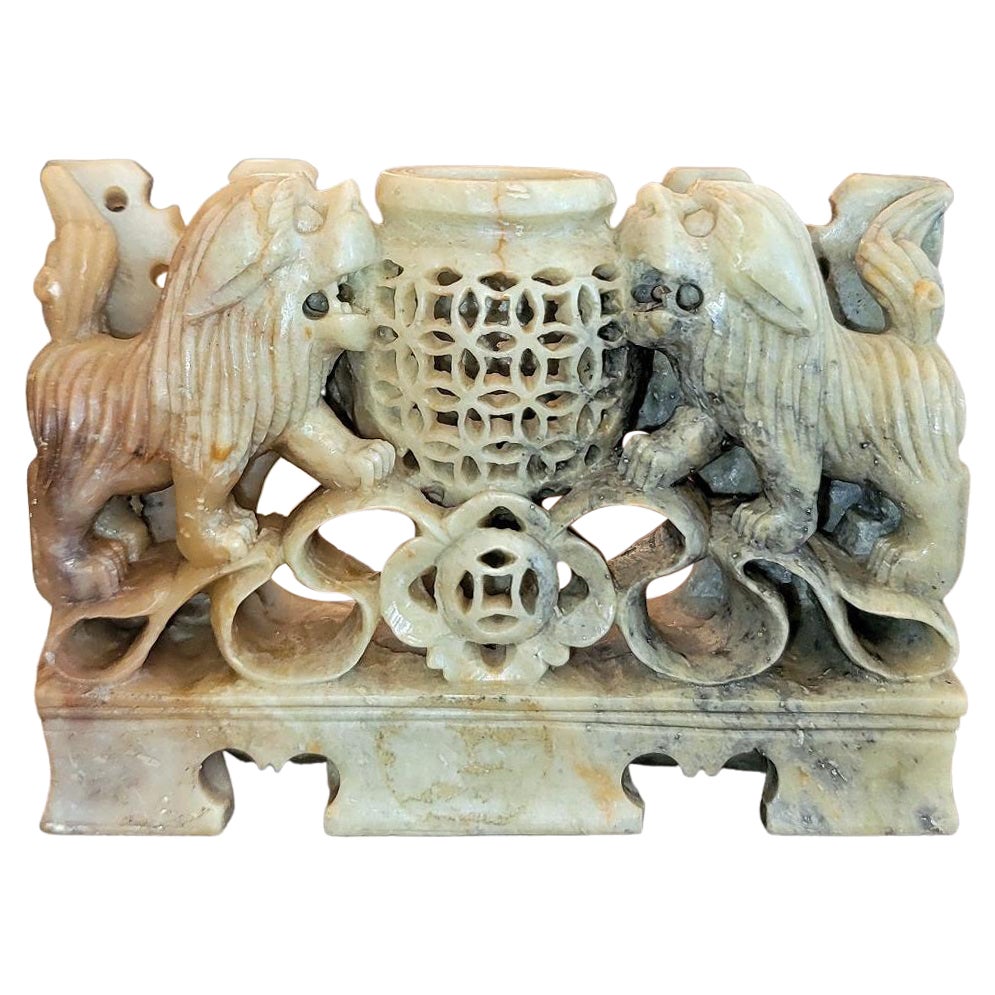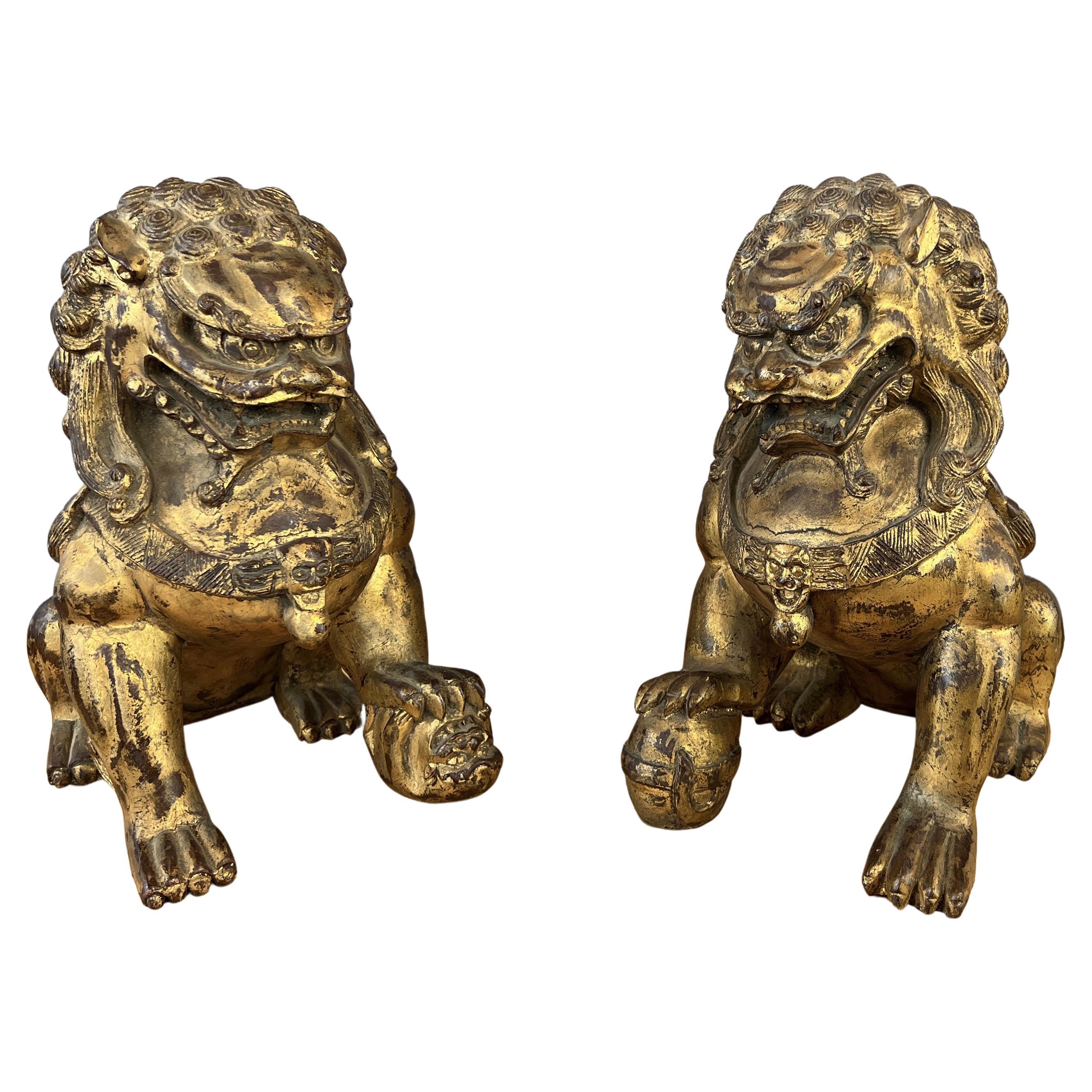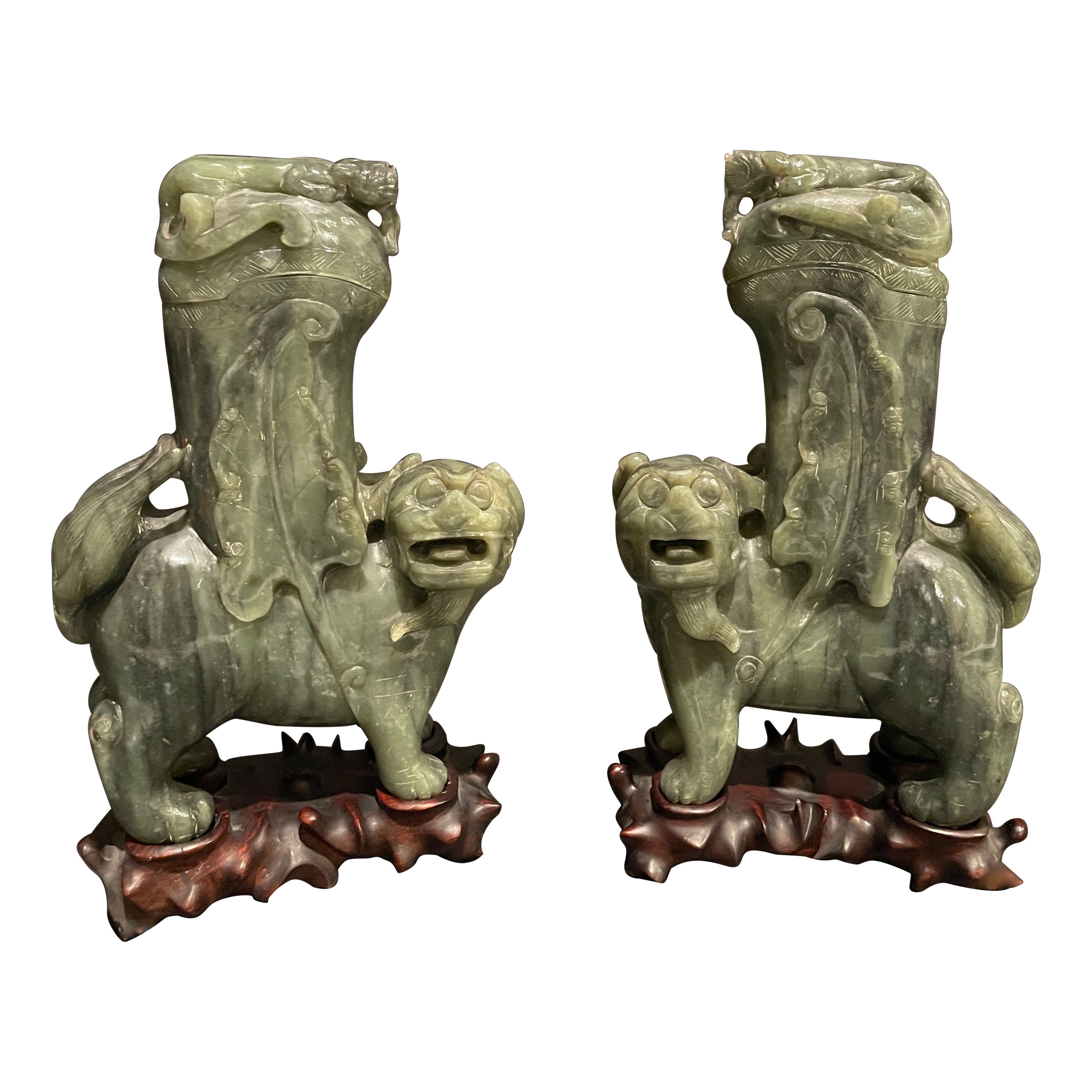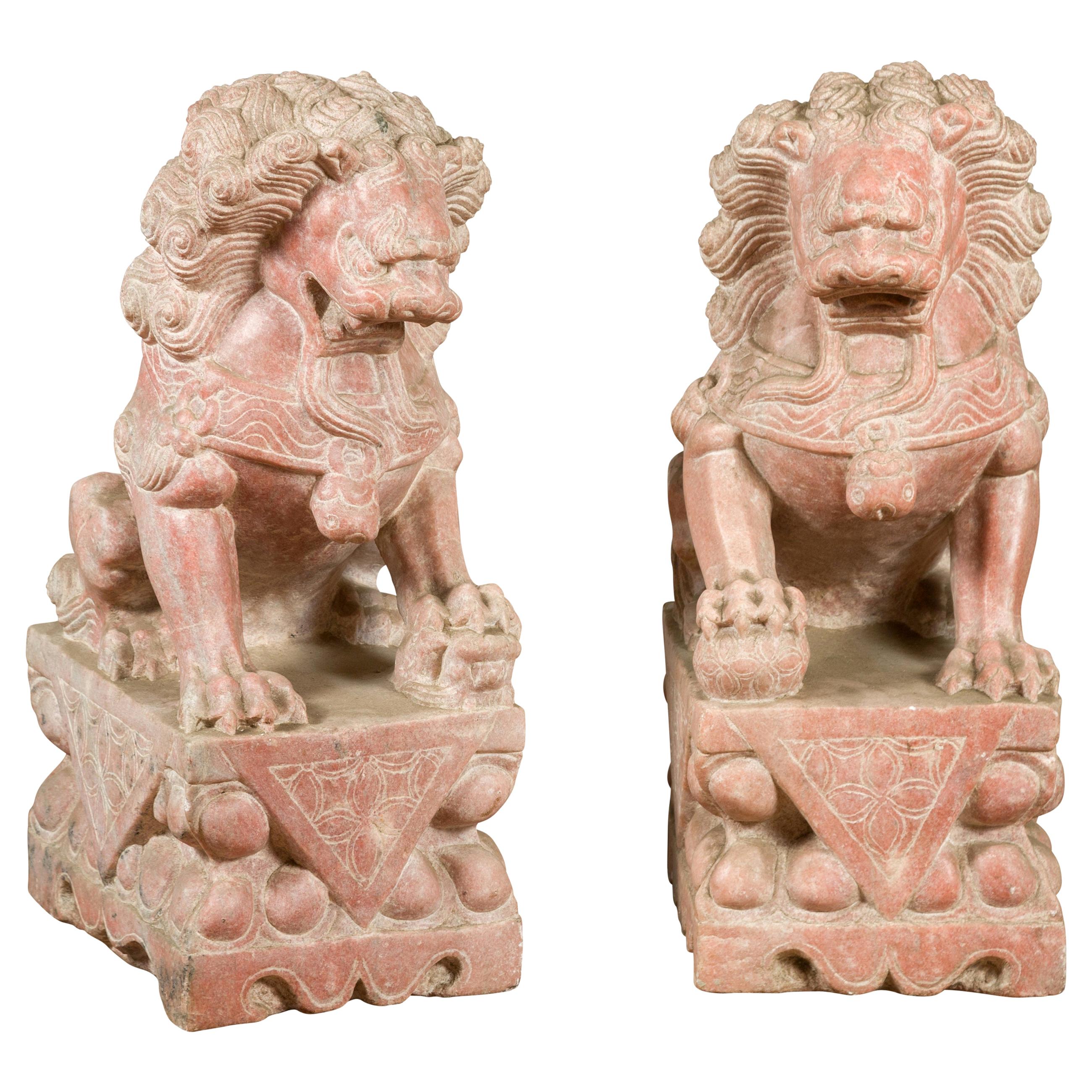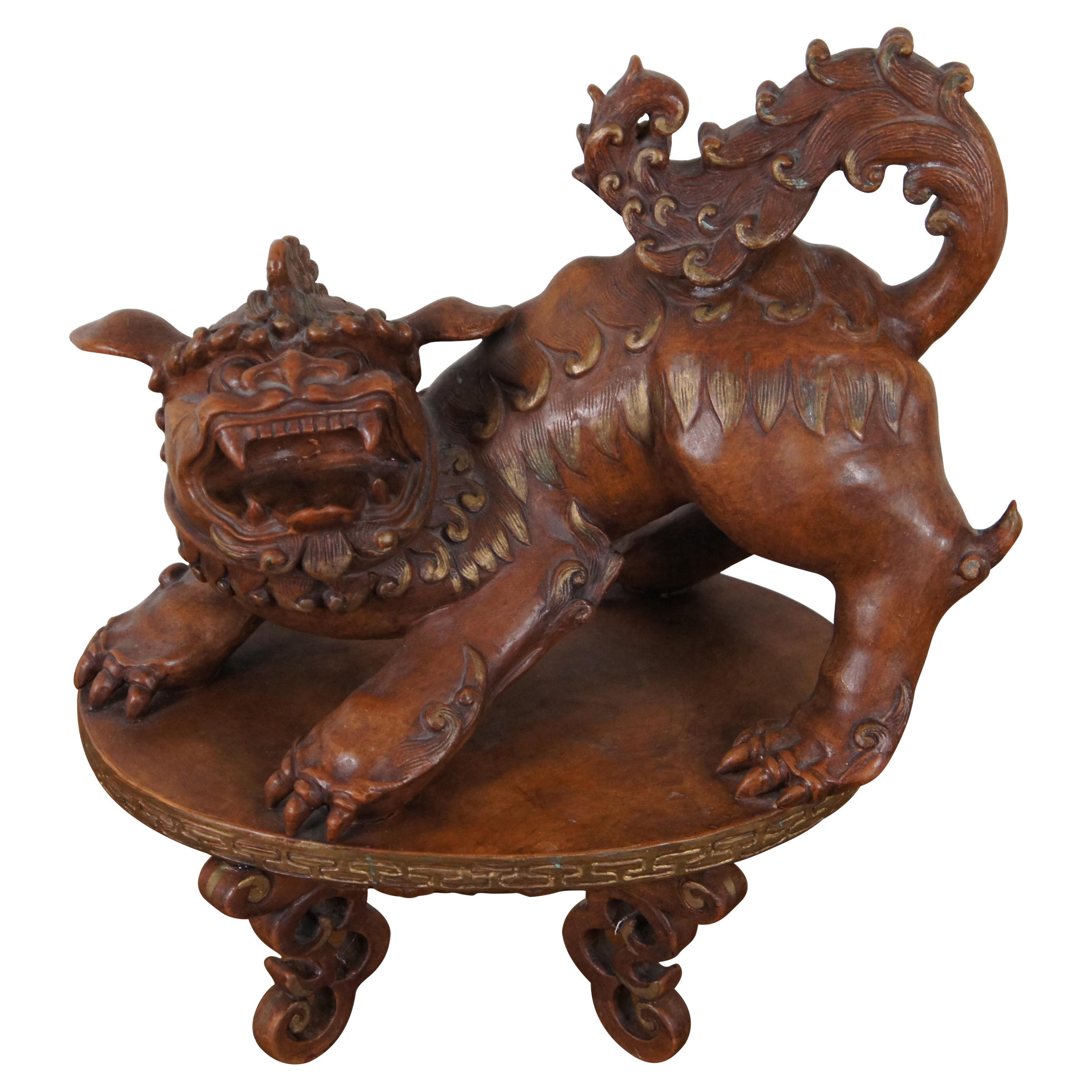Items Similar to Vintage Pair Chinese Pewter Guardian Foo Lions Hong Kong NG AN Signed Mid 20c
Want more images or videos?
Request additional images or videos from the seller
1 of 9
Vintage Pair Chinese Pewter Guardian Foo Lions Hong Kong NG AN Signed Mid 20c
About the Item
Pair of vintage Chinese pewter guardian lions, in fierce sitting pose, with copper accents for sharp claws, and each topped with an adjustable height brass ball attached by a threaded rod.
circa: 1950, Mid 20c
Hallmarks: MADE IN HONG KONG and NG AN WING HING hallmarks to bottom
- Dimensions:Height: 18 in (45.72 cm)Width: 8 in (20.32 cm)Depth: 12 in (30.48 cm)
- Sold As:Set of 2
- Style:Chinese Export (Of the Period)
- Materials and Techniques:
- Place of Origin:
- Period:
- Date of Manufacture:Circa 1950
- Condition:Wear consistent with age and use. Good vintage condition, see detailed photos.
- Seller Location:Richmond, CA
- Reference Number:1stDibs: LU9161238290532
About the Seller
No Reviews Yet
Vetted Seller
These experienced sellers undergo a comprehensive evaluation by our team of in-house experts.
1stDibs seller since 2023
9 sales on 1stDibs
Typical response time: <1 hour
- ShippingRetrieving quote...Ships From: Richmond, Canada
- Return PolicyA return for this item may be initiated within 3 days of delivery.
More From This SellerView All
- Pair Antique Chinese Carved Celadon Jade Guardian Lions ROC Early 20th CenturyLocated in Richmond, CAThis exquisite pair of celadon jade guardian lions hails from the early Republic of China period, a testament to the era's craftsmanship. The lions are intricately carved from high-q...Category
Early 20th Century Chinese Chinese Export Sculptures and Carvings
MaterialsJade
- Vintage Chinese Ceramic Bust of Guanyin Kwan Yin Buddha On Wood Stand mid-20cLocated in Richmond, CAThis Chinese ceramic bust of Kwan Yin (Guanyin), the revered bodhisattva of compassion in Buddhist tradition, is a beautifully crafted representation of spiritual serenity and grace....Category
20th Century Chinese Chinese Export Sculptures and Carvings
MaterialsCeramic
- Large Chinese Natural Translucent Untreated Jadeite Flower Cat Birds Carving 20cLocated in Richmond, CAThis modern Chinese sculpture, standing at an impressive 10 inches on its stand, is a masterful representation of contemporary jadeite craftsmanship, particularly from the renowned Suzhou tradition. Carved from natural, untreated jadeite, the sculpture presents a captivating scene of a blooming flower, complete with two small birds perched atop and a preying feline lurking beneath the intricately carved canopy of leaves and petals. The jadeite material selected for this piece is of exceptional quality, exhibiting a pale celadon green hue that is both translucent and rich in lustre, reminiscent of the finest examples of jadeite. The translucency of the material enhances the sculpture's visual appeal, allowing light to filter through and illuminate the delicate details of the carving, while the wet lustre finish adds a sense of depth and vibrancy to the piece. The scene depicted is one of natural harmony and beauty, yet it is imbued with the dynamic tension of the natural world, as evidenced by the presence of the preying feline. This juxtaposition adds a layer of narrative depth to the sculpture, making it not just a decorative item but a work of art that tells a story. Crafted with the fine modern techniques of Suzhou jadeite craftsmanship, this sculpture is a testament to the skill and artistry of contemporary jade carvers, who continue to uphold the rich traditions of Chinese jade carving...Category
20th Century Chinese Chinese Export Sculptures and Carvings
MaterialsJade
- Large Chinese Natural Untreated Jadeite Foo Dog Lion Seal Stone Carving w StandLocated in Richmond, CAThis modern Chinese jadeite seal stone, standing at an impressive 8 inches on its stand, is a remarkable piece of artistry, showcasing the exquisite craftsmanship associated with contemporary Chinese jade carving...Category
20th Century Chinese Chinese Export Sculptures and Carvings
MaterialsJade
- Chinese Finely Carved A-Grade Lavender Jadeite Dragon Seal on Stand Modern 20cLocated in Richmond, CAThis large exquisite A-grade jadeite seal presents a masterful carving of a scaly dragon, rendered in a delicate shade of pale lavender. The dragon, a symbol of power, strength, an...Category
20th Century Chinese Qing Sculptures and Carvings
MaterialsJade
- Large Italian A.Santini Faux Ivory Tusk Carving God of Longevity Chinoiserie 20cLocated in Richmond, CAA huge Italian A.Santini faux ivory resin sculpture in a curved tusk form, standing 25" tall, of a detailed Chinese god of Longevity standing with a child, mounted upon a stand with ...Category
Mid-20th Century Italian Chinese Export Sculptures and Carvings
MaterialsResin
You May Also Like
- 20C Chinese Soapstone Foo Dog CarvingLocated in Dallas, TXPresenting a lovely 20C Chinese soapstone foo dog carving. Made in China in the early 20th century circa 1930. This is a small green and brown ...Category
Early 20th Century Chinese Chinese Export Sculptures and Carvings
MaterialsSoapstone
- Vintage Pair Chinese Gilt Carved Wood Foo Dog / Guardian Lions FigurinesLocated in San Francisco, CAOffered here are a pair vintage Chinese gilt and carved wood Foo Dog/Guardian Lions figurines Wonderful craftsmanship with the hand carving that has gone...Category
Vintage 1940s Chinese Chinese Export Sculptures and Carvings
MaterialsGiltwood
- Pair Of Chinese Hardstone Guardian LionsLocated in Norwood, NJPair of hand carved Chinese Jade hardstone Foo Lions or Fu Dogs. This pair of Chinese spinach jade appears to be a nephrite, covered vases having a figural foo lion design with raise...Category
Antique Late 19th Century Chinese Chinese Export Sculptures and Carvings
MaterialsJade
- A pair of 19th Century carved Foo temple dogs or Chinese guardian LionsLocated in London, GBChinese guardian lions, or imperial guardian lions, are a traditional Chinese architectural ornament. Typically made of stone, they are also known as stone lions or shishi (石獅; shíshī). They are known in colloquial English as lion dogs or foo dogs / fu dogs. The concept, which originated and became popular in Chinese Buddhism, features a pair of highly stylized lions—often one male with a ball and one female with a cub—which were thought to protect the building from harmful spiritual influences and harmful people that might be a threat. Used in imperial Chinese palaces and tombs, the lions subsequently spread to other parts of Asia including Japan (see komainu), Korea, Philippines, Tibet, Thailand, Myanmar, Vietnam, Sri Lanka, Nepal, Cambodia, Laos, and Malaysia. There has been extensive interaction between Chinese mythology and Confucianism, Taoism, and Buddhism. Elements of pre-Han dynasty mythology such as those in Classic of Mountains and Seas were adapted into these belief systems as they developed (in the case of Taoism), or were assimilated into Chinese culture (in the case of Buddhism). Elements from the teachings and beliefs of these systems became incorporated into Chinese mythology. For example, the Taoist belief of a spiritual Paradise became incorporated into mythology as the place where immortals and deities used to dwell. Sometimes mythological and religious ideas have become widespread across China's many regions and diverse ethnic societies. In other cases, beliefs are more limited to certain social groups, for example, the veneration of white stones by the Qiang. One mythological theme that has a long history and many variations involves a shamanic world view, for example in the cases of Mongolian shamanism among the Mongols, Hmong shamanism among the Miao people, and the shamanic beliefs of the Qing dynasty from 1643 to 1912, derived from the Manchus. Politically, mythology was often used to legitimize the dynasties of China, with the founding house of a dynasty claiming a divine descent. Mythology and philosophy. Further information: Chinese philosophy True mythology is distinguished from philosophical treatises and theories. Elaborations on the Wu Xing are not really part of mythology, although belief in five elements could appear. The Hundred Schools of Thought is a phrase suggesting the diversity of philosophical thought that developed during the Warring States of China. Then, and subsequently, philosophical movements had a complicated relationship with mythology. However, as far as they influence or are influenced by mythology, divides the philosophical camps into two rough halves, a Liberal group and a Conservative group. The liberal group being associated with the idea of individuality and change, for example as seen in the mythology of divination in China, such as the mythology of the dragon horse that delivered the eight bagua diagrams to Fu Xi, and methods of individual empowerment as seen in the Yi Jing (Book of Changes). The Liberal tendency is towards individual freedom, Daoism, and Nature. The relationship of the Conservative philosophies to mythology is seen in the legendary Nine Tripod Cauldrons, mythology about the emperors and central bureaucratic governance, Confucianism, written histories, ceremonial observances, subordination of the individual to the social groups of family and state, and a fixation on stability and enduring institutions. The distinction between the Liberal and Conservative is very general, but important in Chinese thought. Contradictions can be found in the details, however these are often traditional, such as the embrace by Confucius of the philosophical aspects of the Yi Jing, and the back-and-forth about the Mandate of Heaven wherein one dynasty ends and another begins based according to accounts (some of heavily mythological) where the Way of Heaven results in change, but then a new ethical stable dynasty becomes established. Examples of this include the stories of Yi Yin, Tang of Shang and Jie of Xia or the similar fantastic stories around Duke of Zhou and King Zhou of Shang. Mythology exists in relationship with other aspects of society and culture, such as ritual. Various rituals are explained by mythology. For example, the ritual burning of mortuary banknotes (Hell Money), lighting fireworks, and so on. A good example of the relationship of Chinese mythology and ritual is the Yubu, also known as the Steps or Paces of Yu. During the course of his activities in controlling the Great Flood, Yu was supposed to have so fatigued himself that he lost all the hair from his legs and developed a serious limp. Daoist practitioners sometimes incorporate a curiously choreographed pedal locomotion into various rituals. Mythology and practice, one explains the other: in these rituals, the sacred time of Yu merges with the sacral practice of the present. Various ideas about the nature of the earth, the universe, and their relationship to each other have historically existed as either a background or a focus of mythologies. One typical view is of a square earth separated from a round sky by sky pillars (mountains, trees, or undefined). Above the sky is the realm of Heaven, often viewed of as a vast area, with many inhabitants. Often the heavenly inhabitants are thought to be of an "as above so below" nature, their lives and social arrangements being parallel to those on earth, with a hierarchical government run by a supreme emperor, many palaces and lesser dwellings, a vast bureaucracy of many functions, clerks, guards, and servants. Below was a vast under ground land, also known as Diyu, Yellow Springs, Hell, and other terms. As time progressed, the idea of an underground land in which the souls of the departed were punished for their misdeeds during life became explicit, related to developments in Daoism and Buddhism. The underground world also came to be conceived of as inhabited by a vast bureaucracy, with kings, judges, torturers, conductors of souls, minor bureaucrats, recording secretaries, similar to the structure of society in the Middle Kingdom (earthly China). Chinese temple Dogs...Category
Antique 1860s Chinese Chinese Export Sculptures and Carvings
MaterialsHardwood
- Pair of Chinese Vintage Foo Dogs Guardian Lions on Bases with Sandstone PatinaLocated in Yonkers, NYA pair of vintage Chinese stone Foo Dogs guardian lions from the mid-20th century, with sandstone patina, on rectangular bases. Created in China...Category
Mid-20th Century Chinese Sculptures and Carvings
MaterialsStone
- Vintage Italian Chalkware Fu Foo Dog Chinese Guardian Lion Sculpture CenterpieceLocated in Dayton, OHVintage Italian chalkware painted sculpture / statue in the shape of a Chinese guardian lion / foo dog, standing on a pedestal or stool. Signed a...Category
Late 20th Century Chinoiserie Animal Sculptures
MaterialsMetal
Recently Viewed
View AllMore Ways To Browse
Wood Carving Elephant
Indonesian Stone Carving
Buddhist Prayer Box
Indonesian Bali Teak Wood Vintage Furniture
Antique Carved Japanese Warrior
Carved Crane
Temple Kyoto
Japanese Temple Kyoto
Marble Elephant Midcentury Statues
Myanmar Pottery
Finely Carved Japanese Okimono
Jade Guanyin Statue
Wood Carving Salmon
Japanese Tanuki
Himalayan Bronze
Burmese Kinnari Statue
Chinese Bound Foot Shoes
Chinese Jade Pig
